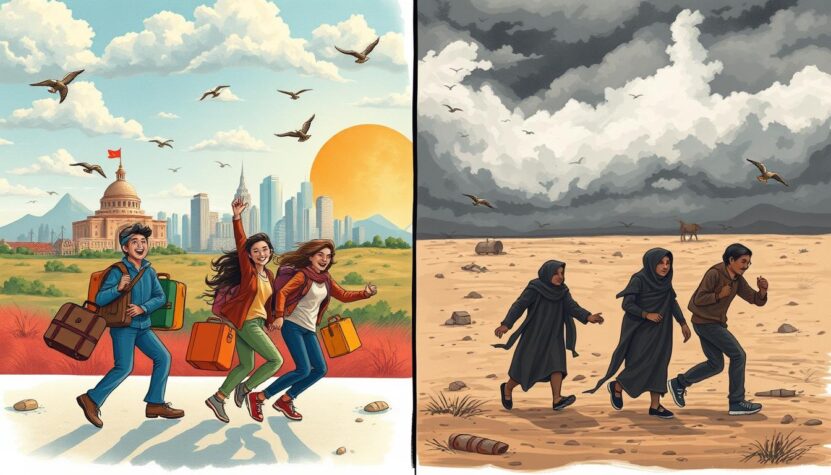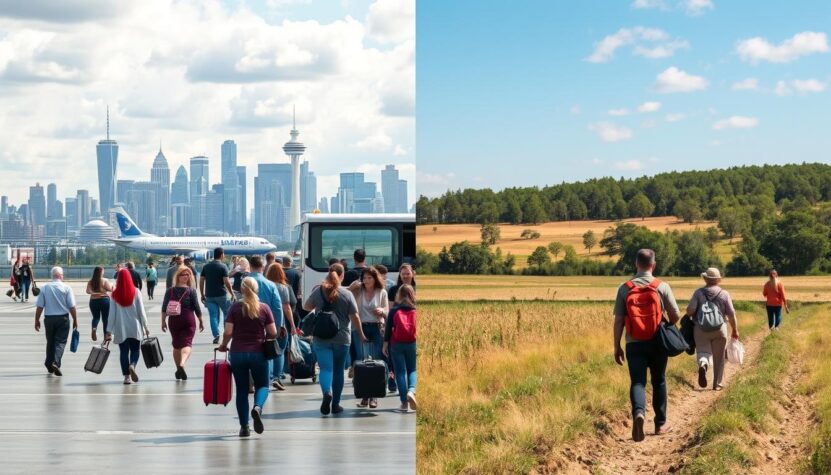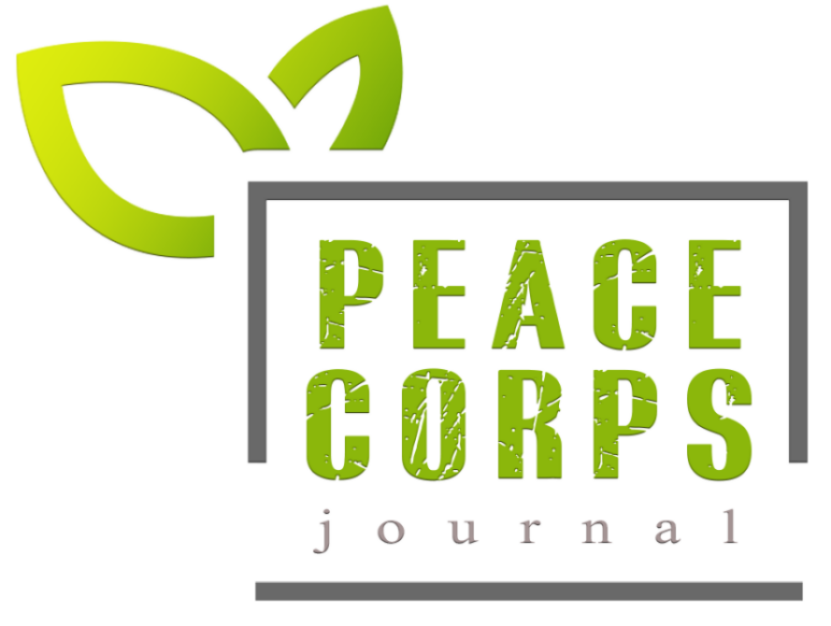In a world increasingly shaped by movement, understanding the difference between an immigrant and a migrant is crucial. A staggering 120 million men, women, and children have been forced to flee their homes due to conflicts, violence, and persecution. As this phenomenon rises, the distinction between immigrant vs migrant plays a vital role in international discussions on human rights, legal status, and migration patterns. With refugee, asylum seeker, and internally displaced person numbers having doubled over the past decade, many are left questioning how these terms apply to various scenarios.
As of the end of 2023, there were approximately 6.9 million asylum seekers awaiting decisions, with a notable 26% increase in applications submitted to countries like the United States and Germany. The main nationalities seeking asylum include individuals from Venezuela, Colombia, Syria, Sudan, and Afghanistan, highlighting the global nature of this issue. Each minute, 20 people are compelled to flee their homes, often making life-altering decisions within mere moments, which underscores the urgency behind understanding the difference between immigrant and migrant.
In this article, we will explore the distinctions, legal frameworks, and motivations behind each term, offering insights into the challenges faced by individuals in these situations. You will come away with a clearer understanding of what it means to be an immigrant and what it means to be a migrant, as we delve into these pressing global matters.
Understanding Migration
Understanding migration involves recognizing the movement of individuals from one location to another, whether it occurs domestically within a country or internationally across borders. Migration can be voluntary or involuntary, shaped by various social, economic, and political factors. Over 281 million international migrants currently make up 3.6% of the world’s population, indicating the global significance of this phenomenon.
The classification of migrants often varies based on country of birth, nationality, and the duration of their stay. For instance, 19% of employed individuals in the UK during the second quarter of 2023 were foreign-born, while 13% held foreign national status. These statistics highlight the contribution of migrants to the labor market, influencing policy-making decisions surrounding employment and social services.
Understanding migration terminology is crucial in grasping the challenges faced by different groups. Immigrants are those who move permanently from one country to another, whereas migrants may relocate within their home country or move internationally without official legal pathways. The implications of these definitions extend beyond individual experiences; they affect public policy and public opinion regarding migration.
Social issues also arise within the context of migration. Migrant children often face heightened risks, including discrimination, exploitation, and forced labor. Advocacy groups, such as the International Catholic Migration Commission (ICMC), work tirelessly to uphold the rights of these vulnerable populations, recognizing the many complexities in addressing these issues.
Defining Immigrants
Understanding the concept of immigrants requires a close look at the essential immigrant definitions that differentiate them from others. Essentially, what makes someone an immigrant is the intention to move and reside in a foreign country, often following a well-thought-out plan. This migration reflects their desire to settle and build a new life in a different environment.
Characteristics of Immigrants
Immigrants share various characteristics, including:
- A conscious decision to relocate, demonstrating agency and intent.
- Extensive research and planning regarding their new home, whether for employment, education, or family reasons.
- The pursuit of stability and security in their lives, influenced by factors in their home countries.
Legal Status of Immigrants
The immigrant legal status determines an individual’s rights and responsibilities within the new country. Immigrants typically undergo a vetting process to secure the necessary documents, such as visas or residency permits. This process is critical, as having proper documentation allows them to access opportunities and establish a life safely. The journey does not end with moving; many immigrants aspire to achieve citizenship, further solidifying their commitment to their adopted nation.
Defining Migrants
Understanding migrant definitions is essential for grasping the complexities of global movement. Migrants are individuals who relocate primarily for economic opportunities or to improve their living conditions. Unlike immigrants, their intention may not involve settling permanently in a new country. Often, they seek short-term work or educational experiences, embracing flexibility in their circumstances.
Characteristics of Migrants
The characteristics of migrants are diverse, reflecting a variety of backgrounds and circumstances. Here are some notable traits:
- Migrants often face severe discrimination, particularly in areas such as housing, education, and employment.
- Many migrants work in the informal sector, making them vulnerable to exploitation and marginalization.
- Individuals may be categorized differently depending on definitions, impacting statistics related to migratory trends.
- Migrants in irregular situations encounter heightened risks, including limited access to essential services.
- Campaigns advocating for their rights seek to ensure governments uphold their responsibilities to protect both migrants and refugees.
International organizations emphasize that the right to seek asylum, as per the Universal Declaration of Human Rights and the UN Refugee Convention, underlines the importance of acknowledging the safety of all migrants. The Global Compact for Safe, Orderly, and Regular Migration stresses the necessity of ethical recruitment and protection for migrant workers, particularly in industries like tourism.
In the context of crisis situations, such as during the COVID-19 pandemic, migrants have experienced increased vulnerabilities, highlighting the need for comprehensive protections. Governments must strive to ensure that applicable laws do not discriminate against these individuals, or leave them living in poverty.
| Aspect | Migrants | Immigrants |
|---|---|---|
| Intention | Temporary relocation for work or education | Permanently settle in a new country |
| Legal Status | Can be regular or irregular | Often have a defined legal status |
| Vulnerability | Higher risk of discrimination and exploitation | May face legal challenges but generally have more protections |
| Rights | Limited access to basic services; subject to discrimination | Protected by immigration laws in host countries |
In today’s environment, with approximately 35 million refugees globally, understanding the nuances of migrant definitions and the characteristics of migrants becomes increasingly important. As you explore the realities of those on the move, remember that clarity in definitions can foster more effective policies and support systems for this vulnerable population.
Difference Between an Immigrant and a Migrant?
The concepts of immigrant and migrant often create confusion in discussions about movement across borders. Understanding the difference between immigrant and migrant is essential for comprehending legal classifications and societal attitudes. An immigrant typically seeks to settle in a new country with the intention of permanent residence. In contrast, a migrant may not have the same intent and can represent a more transient status, often moving for temporary reasons such as economic opportunities or fleeing conflict.
Agency and intent play crucial roles in distinguishing these two terms. Immigrants usually undergo specific processes to gain legal residence and stability in their new country. In contrast, migrants might not be seeking permanent status, emphasizing the difference between immigrant and migrant. Temporary work opportunities or educational pursuits often drive migrant movements.
The plight of asylum seekers complicates the definitions further. Many individuals fleeing violence and disaster, such as those from Central America, find themselves in situations where they must navigate the challenging environments of both immigration and migration. Asylum seekers often fall into both categories, illustrating complex realities. Statistically, around 6.9 million individuals, including those from Venezuela and Syria, are currently seeking asylum. This situation highlights the spectrum of experiences among those identified as migrants or immigrants.
Societal perceptions surrounding migrants and immigrants can also influence public policies and attitudes. For example, without clear definitions, individuals in need of assistance may be viewed primarily as transient migrants, rather than potential contributing members of society. The ongoing debates over immigration reform and migrant rights frequently stem from these misunderstandings.
Motivations for Migration
Migrations arise from a multitude of driving forces, shaping the lives of individuals and communities worldwide. Two primary motivations for migration include economic opportunities and safety considerations, particularly regarding asylum seekers. Understanding these motivations provides insight into how and why people make the pivotal decision to relocate.
Economic Reasons
A significant portion of international migrants is drawn to regions with better economic prospects. Motivations for migration rooted in economic factors include:
- Seeking higher wages
- Finding improved job opportunities
- Accessing better living standards
Immigrants often target high-income countries to capitalize on growing labor demands. Research indicates that immigrant workers, estimated at around 164 million globally, comprise nearly two-thirds of international migrants. This migration can bolster the labor force and enhance a nation’s productive capacity, leading to increased tax revenues and economic growth.
Safety and Asylum Seeker Context
Another pressing motivation for migration involves safety, especially for asylum seekers fleeing conflict and persecution. People driven by fear of violence often find themselves crossing borders in search of refuge. Statistics reveal that in 2022 alone, the EU granted protection status to 384,245 asylum seekers, with over a quarter from Syria. Individuals from Afghanistan and Venezuela also represented significant numbers.
Asylum seekers face urgent circumstances that compel them to leave their home countries. The complexities surrounding these migrations underscore the critical need for empathetic and effective immigration policies. With the growing number of individuals seeking refuge, the global community must strive to create solutions that address both the humanitarian and logistical challenges of migration.
| Motivation for Migration | Examples | Impact |
|---|---|---|
| Economic Opportunities | Higher wages, job vacancies | Boosts labor market, enhances economy |
| Safety and Protection | Fleeing violence, persecution | Demand for asylum, need for humanitarian aid |
Types of Migration
Understanding the different types of migration is crucial for appreciating the complexities surrounding this global phenomenon. Migration can be categorized mainly into two groups: voluntary and involuntary migration. Each type carries distinct motivations and implications for the individuals involved, shaping their experiences and challenges throughout the migration process.
Voluntary vs. Involuntary Migration
Voluntary migration occurs when individuals make the choice to relocate for various reasons. These reasons often include economic opportunities, educational pursuits, or family reunification. On the other hand, involuntary migration takes place when individuals are compelled to leave their homes due to external factors such as conflict, violence, or natural disasters. This distinction plays a significant role in the experiences and protections available to migrants.
| Type of Migration | Definition | Common Reasons | Implications |
|---|---|---|---|
| Voluntary Migration | Migration driven by personal choice. |
|
Generally offers more agency and legal protections. |
| Involuntary Migration | Migration due to external pressures or forces. |
|
May lead to urgent humanitarian responses and complex legal challenges. |
The worldwide increase in migration has highlighted the crucial role of understanding the various types of migration. Recognizing the differences between voluntary and involuntary migration contributes to more informed discussions regarding migrant rights and protections under international laws.

Migrant Rights and Protections
Migrant rights encompass a wide range of legal, social, and humanitarian protections for individuals who move across borders. These rights are not only essential for safeguarding the dignity and welfare of migrants but also pivotal in promoting social justice and equity. Effective protections for migrants often stem from international laws and conventions, including the 1951 Refugee Convention, which outlines fundamental rights for refugees. Misunderstandings regarding the distinction between migrants and refugees can lead to significant legal and humanitarian implications. Recognizing these distinctions enables governments and organizations to provide appropriate legal responses and necessary protections for migrants.
Migrant rights include access to essential services, legal representation, and protection from discrimination. Advocating for these rights affects diverse groups, including asylum seekers, economic migrants, and refugees. Family reunification is often a central aspect of protections for migrants. U.S. immigration policy allows citizens to sponsor family members for lawful permanent resident (LPR) status, making family-based immigration a key priority within the immigration framework. Subsequently, approximately 58% of new LPRs in FY 2022 came through family-based visas.
Many organizations work diligently to ensure migrants are aware of their rights and have access to the resources necessary for their protection. This advocacy extends to various facets of migrants’ lives, including the opportunity for education and healthcare services. For instance, access to these services is fundamental for the integration of migrants into host communities, contributing positively to social cohesion and economic growth.
Efforts to uphold migrant rights are vital, especially as global displacement continues to rise. The United Nations reports over 65 million people have been forcibly displaced worldwide, underscoring the critical need for coherent legal frameworks and humanitarian responses. These frameworks help define protections for migrants and address the unique challenges faced by individuals seeking refuge from war, persecution, or adversity.
| Type of Protection | Description |
|---|---|
| Legal Status | Rights related to asylum, refugee status, and lawful residency. |
| Access to Education | The right to enroll in local schools and receive education without bias. |
| Healthcare Access | Safeguards ensuring that migrants can access necessary medical services. |
| Legal Representation | Access to legal aid and support during immigration processes. |
| Family Reunification | Policies allowing family members to reunite and live together in the host country. |
Legal Framework Surrounding Immigration vs. Migration
The legal framework governing immigration vs migration plays a crucial role in understanding how different categories of individuals are treated within various contexts. This framework includes numerous international laws and standards aimed at protecting the rights of those who migrate for various reasons, such as safety, work, or family reunification. Both migrants and refugees are recognized under key legal instruments, ensuring their fundamental human rights are respected regardless of their status.
International Laws
International human rights treaties form the backbone of rights protection for migrants and refugees. Instruments like the International Covenant on Economic, Social, and Cultural Rights (ICESCR) and the International Covenant on Civil and Political Rights (ICCPR) outline the rights that apply universally. Principles such as non-refoulement, which prohibits returning individuals to places where they may face threats, and the prohibition against racial discrimination are essential elements of customary international law concerning migration.
U.S. Immigration Policy
U.S. immigration policy reflects legal distinctions that significantly influence the treatment of migrants within the country. Policies create pathways for residency and citizenship but also establish the legal definitions that determine who qualifies as an immigrant or a refugee. The ongoing discourse surrounding U.S. immigration policy often intertwines with international frameworks, especially as mixed movements become increasingly common. This complexity highlights the necessity of recognizing individual circumstances to ensure appropriate protections for all groups involved.

Common Misconceptions
Many misconceptions about immigrants and migrants persist, shaping public perception and influencing policy decisions. For example, a common misunderstanding equates asylum seekers with illegal immigrants, failing to recognize their distinct legal statuses and reasons for seeking refuge. This conflation fosters stigma and hinders constructive conversations about the realities of migration.
Data reveals that as of 2014, the U.S. was home to more than 43 million foreign-born individuals, with various statuses including naturalized citizens, lawful permanent residents, and unauthorized immigrants. Notably, approximately 11 million unauthorized immigrants comprise about 25.5% of the total foreign-born population. Among these, many entered the country legally with valid visas initially, perpetuating the notion that all unauthorized immigrants are criminals.
Another misconception about immigrants concerns their economic contributions. Undocumented immigrants paid an estimated $11.74 billion in state and local taxes in 2017 alone, highlighting that they significantly contribute to the economy. Contrary to popular belief, immigrants are less likely to commit crimes than U.S.-born citizens, being incarcerated at rates 60% lower compared to their native counterparts. Such figures paint a different picture than what is often portrayed in media narratives.
The narrative of competition for jobs is another layer of misunderstanding. Immigrants and their families account for all U.S. civilian labor force growth in the last two decades, crucially filling job openings in sectors such as healthcare. Unemployment rates for U.S.-born workers have remained consistently low, indicating that immigrants support the economy without diminishing opportunities for native workers.
Raising awareness about these misconceptions about immigrants and migrants can lead to more informed discussions. Understanding the complexities of migration not only helps in addressing stigma but also highlights the vital roles immigrants play in American society and the economy.
Conclusion
As you delve into the complexities of understanding migration, it becomes clear that recognizing the immigrant and migrant differences is essential in shaping policies and societal attitudes. We observe significant trends in global migration, particularly the substantial role migrant workers play in the labor force. According to the United Nations International Labour Organization, an impressive 90.7% of international migrants are engaged in work, highlighting their contributions to economic growth in various regions, including the U.S., where they make up 17.4% of the labor force.
The vital statistics regarding labor participation and the diversity of migrant statuses, such as naturalized citizens and lawful permanent residents, underscore the multifaceted nature of migration. While understanding these categories can help you better grasp the dynamics of migration, it also encourages a more empathetic approach to the challenges migrants face, including mental health issues stemming from displacement and culture shock.
In an increasingly mobile world, fostering awareness is crucial for integrating migrant communities into society. Therefore, you are encouraged to explore migration issues further, to advocate for informed perspectives that promote empathy and inclusivity. By doing so, you can contribute to a more harmonious understanding of the complex realities of migration and the people navigating these critical changes in their lives.
